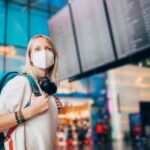Once again, Reddit users and I are on the same wavelength: We’re wondering why riding in an Uber or Lyft makes us so uncomfortably nauseous. The viral thread perfectly captures the stomach-churning phenomenon, further proving that many of us have never had an original experience in our life.
Maybe you’ve experienced this, too. For some reason, the feelings of sickness don’t hit when you’re driving or a friend is behind the wheel, but every time you step in a cab, you know the next 20 minutes or so are going to be rough. Add that to the fact that this mode of transportation is needed so often — to get to the airport, to get home after a night out, because you’re too tired to drive home yourself and on so many other occasions. So what are you to do?
Why you might feel nauseous in Ubers, Lyfts or cabs.
According to doctors, various factors may be at play. Here’s what could be going on:
You’re experiencing motion sickness.
Motion sickness happens when what your eyes see doesn’t match up with what your inner ear senses, according to Dr. Laura Purdy, a board-certified family medicine physician. But how does that explain why nausea only pops up in cabs?
“When driving with friends or riding solo in your own car, your focus remains primarily on the road ahead, while your inner ear picks up movement through its receptors in your inner ears,” Purdy said. “But when in cabs or Uber cars alone, your gaze might remain focused elsewhere, like reading or looking at stationary objects while your inner ears pick up movement through receptors — in both cases, leading to nausea, dizziness and sweating.”
In other words, checking out your driver’s car and the sign on the back of their front headrest probably isn’t in your best interest.
Additionally, as a passenger, you’re already at a disadvantage. “The driver of a car is less likely to experience motion sickness than passengers,” said Dr. Sarah Robbins, a gastroenterologist, gut health expert and founder of Well Sunday. “This may be because the driver’s brain is using different motor skills to control the car and can predict the motion, reducing the sensory mismatch.”
Further, some people are just more prone than others due to other individualistic factors. Robbins listed women, pregnant people, children and people who get migraines as the folks who are the most susceptible.
You’re in the back seat.
Along the lines of motion sickness: If you’ve ridden in the back of a roller coaster and felt especially jerked around, you know what we’re talking about here. “Being back seat is definitely a contributor,” said Dr. Samantha Nazareth, a board-certified gastroenterologist. “You feel more force from the sharp turns.”
Not getting as much air conditioning in the back is a part of this, too. “Being in a stuffy, closed space can increase the likelihood of motion sickness,” Robbins added.
The driver’s driving style is, uh, not great.
We’ve all been there, right? You get into an Uber or Lyft and grip the door a little tightly as they weave in and out of traffic.
“If he or she drives too quickly, makes sudden stops or turns, or travels bumpy roads, this could result in motion sickness and cause nausea in passengers,” Purdy said.
You feel anxious.
It’s also understandable you may worry about your safety in the back of a stranger’s car. At the very least, having to yet again ask “So how long have you been doing this?” can be a bit awkward, right?
That anxiety can manifest in physical ways, which include nausea. Further, that nausea may be extra intense “if riding is unfamiliar territory for you or is new city/route-specific,” Purdy said.

lechatnoir via Getty Images
How to fight nausea during your ride.
While some factors are pretty much out of your control, these experts do have advice that can relieve some of your discomfort. First, knowing the nausea’s source “could provide useful ways of managing it or even preventing future episodes altogether,” according to Purdy. Some tips she, Nazareth and Robbins listed include:
- Ask if you can crack a window for fresh air.
- Ask if you can sit in the front seat if you feel safe to do so.
- Try to stay off your phone and not engage in any reading.
- Look out the window as much as possible, keeping your eyes focused on the horizon or distant points.
- Distract yourself by engaging in conversation or listening to music.
In short, the next time you’re feeling tipsy from a couple of strong cocktails or don’t want to ask a friend to pick you up from the airport, know you can make it through an Uber, Lyft or cab ride. With a little fresh air, some deep breaths, and other small adjustments, the waves of nausea shouldn’t hit you so hard.


